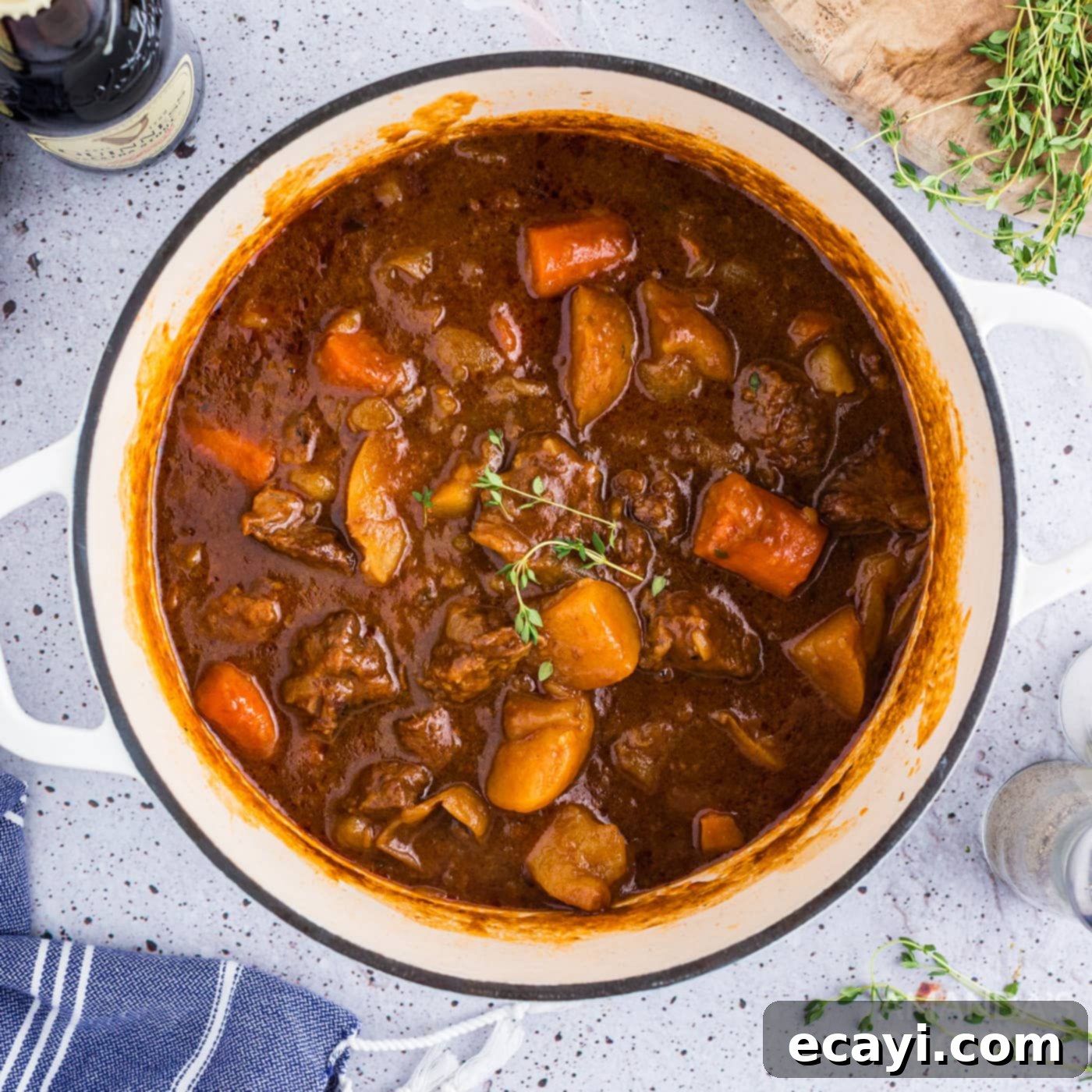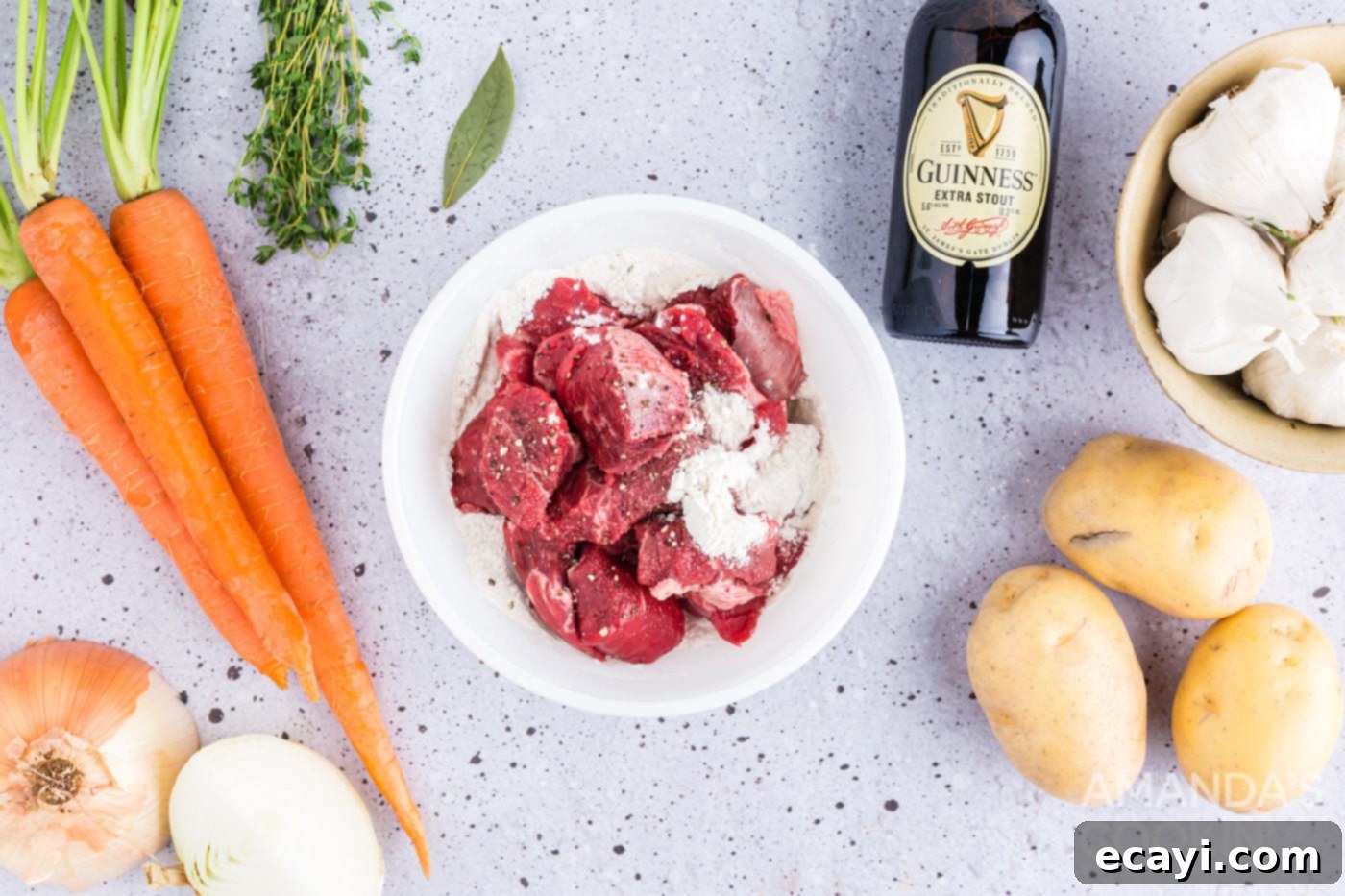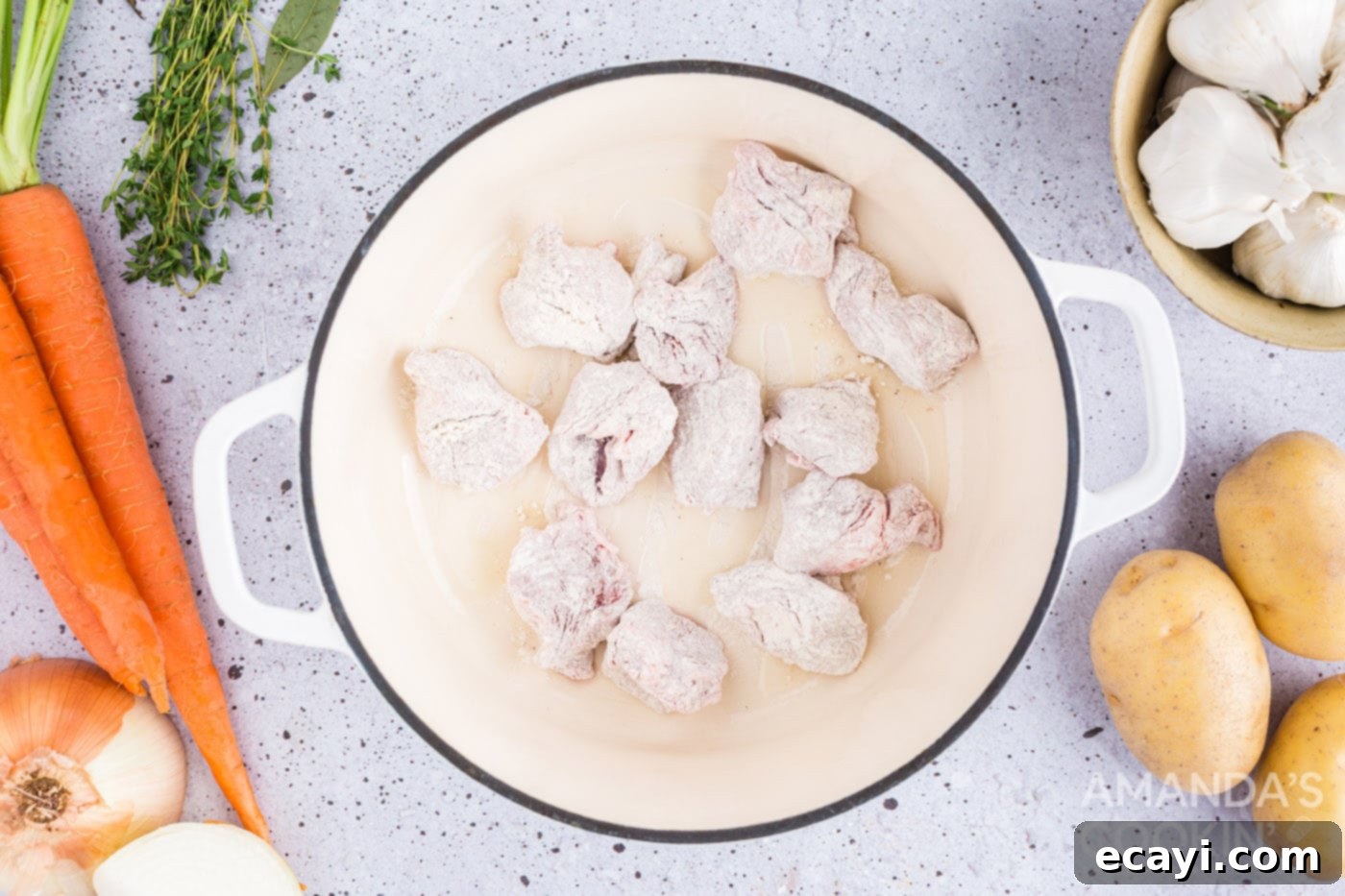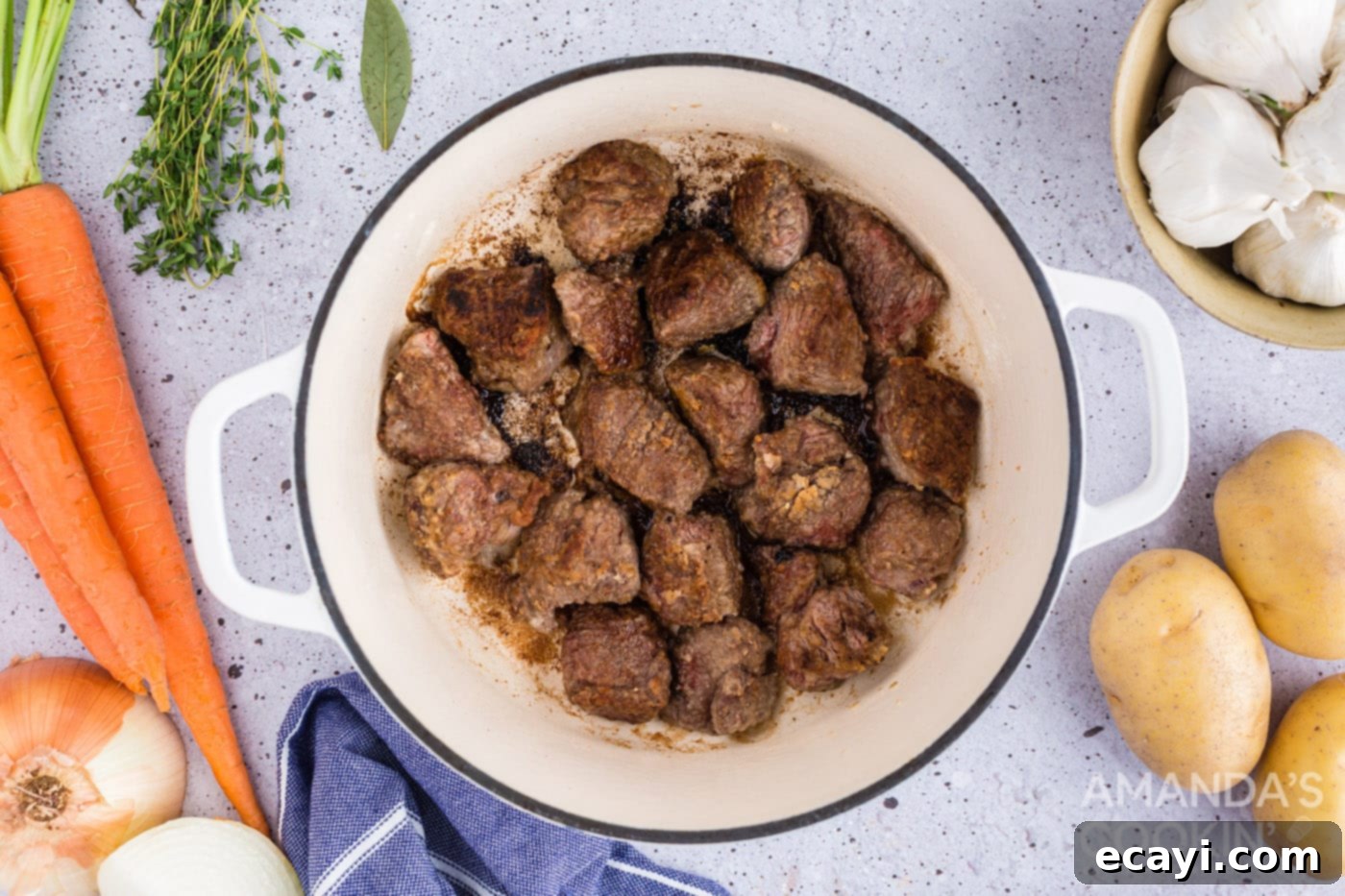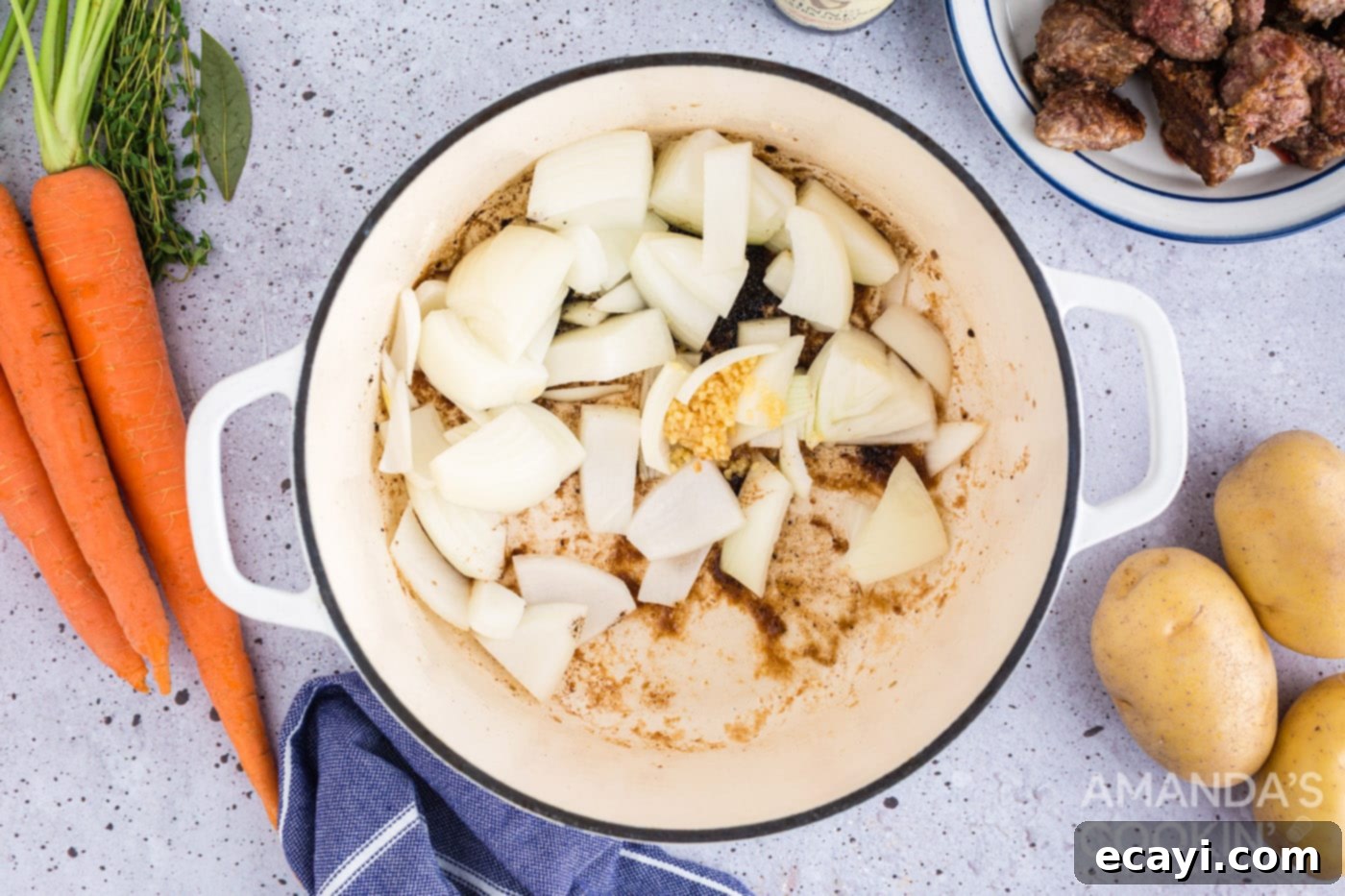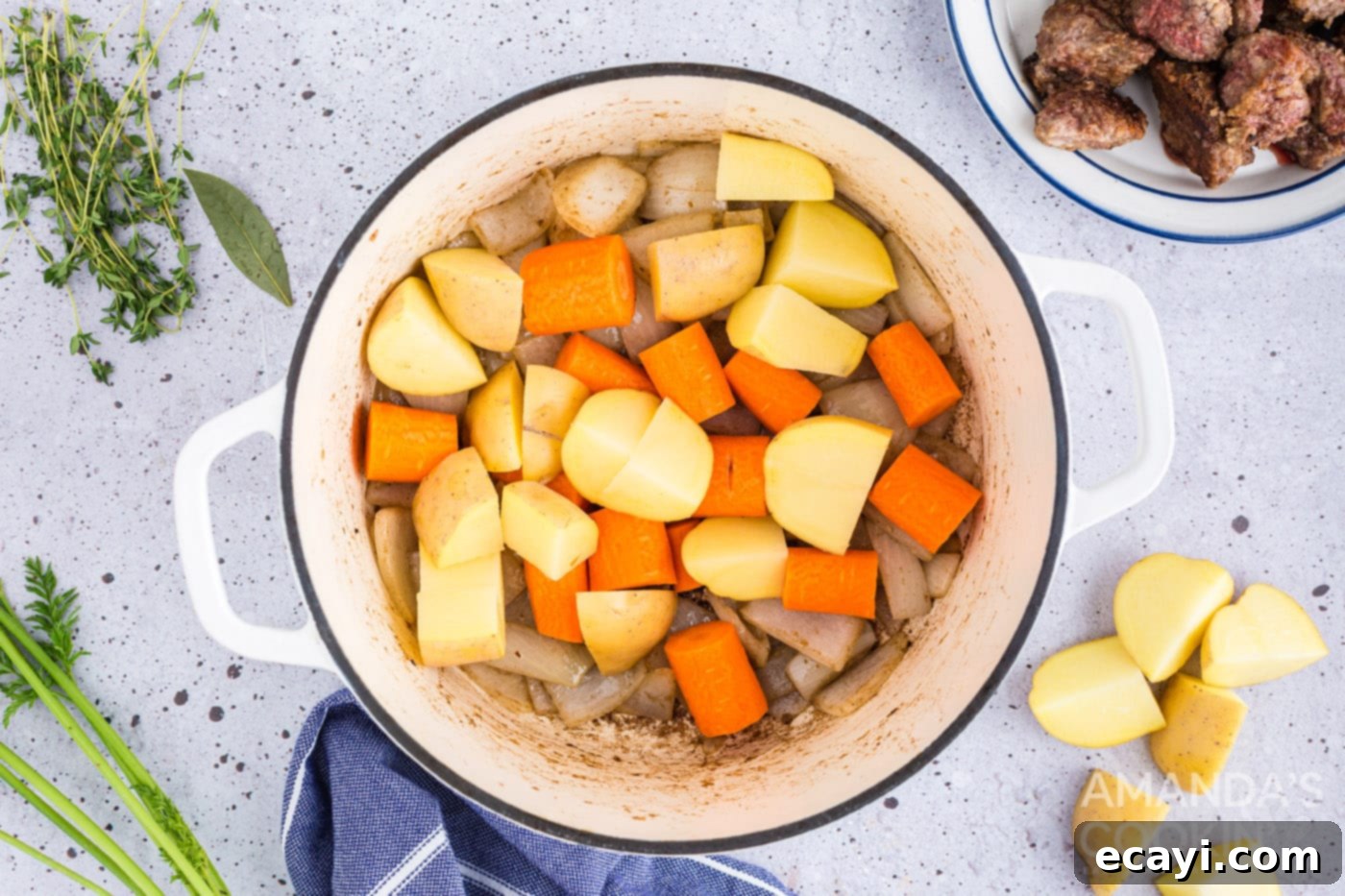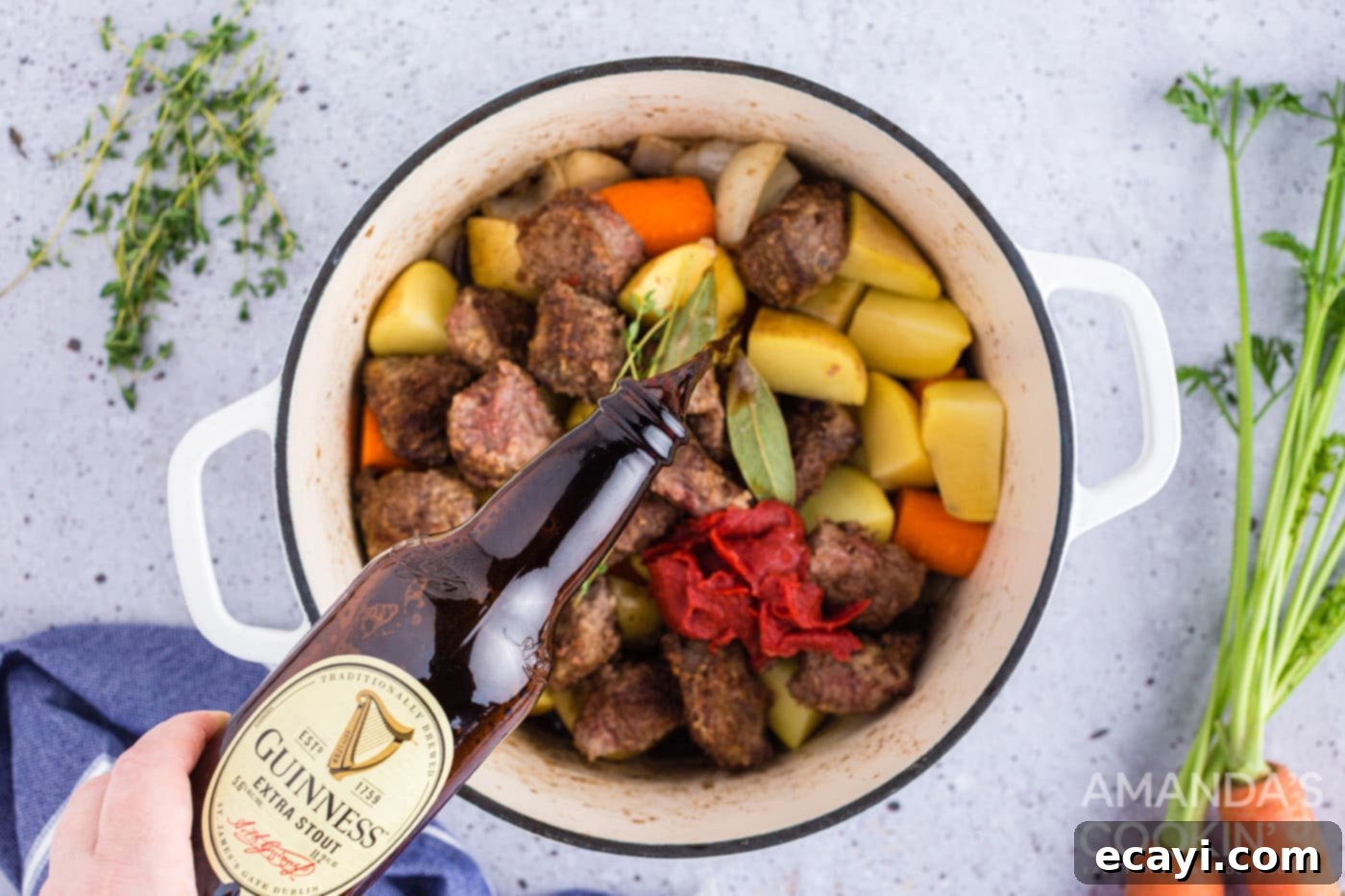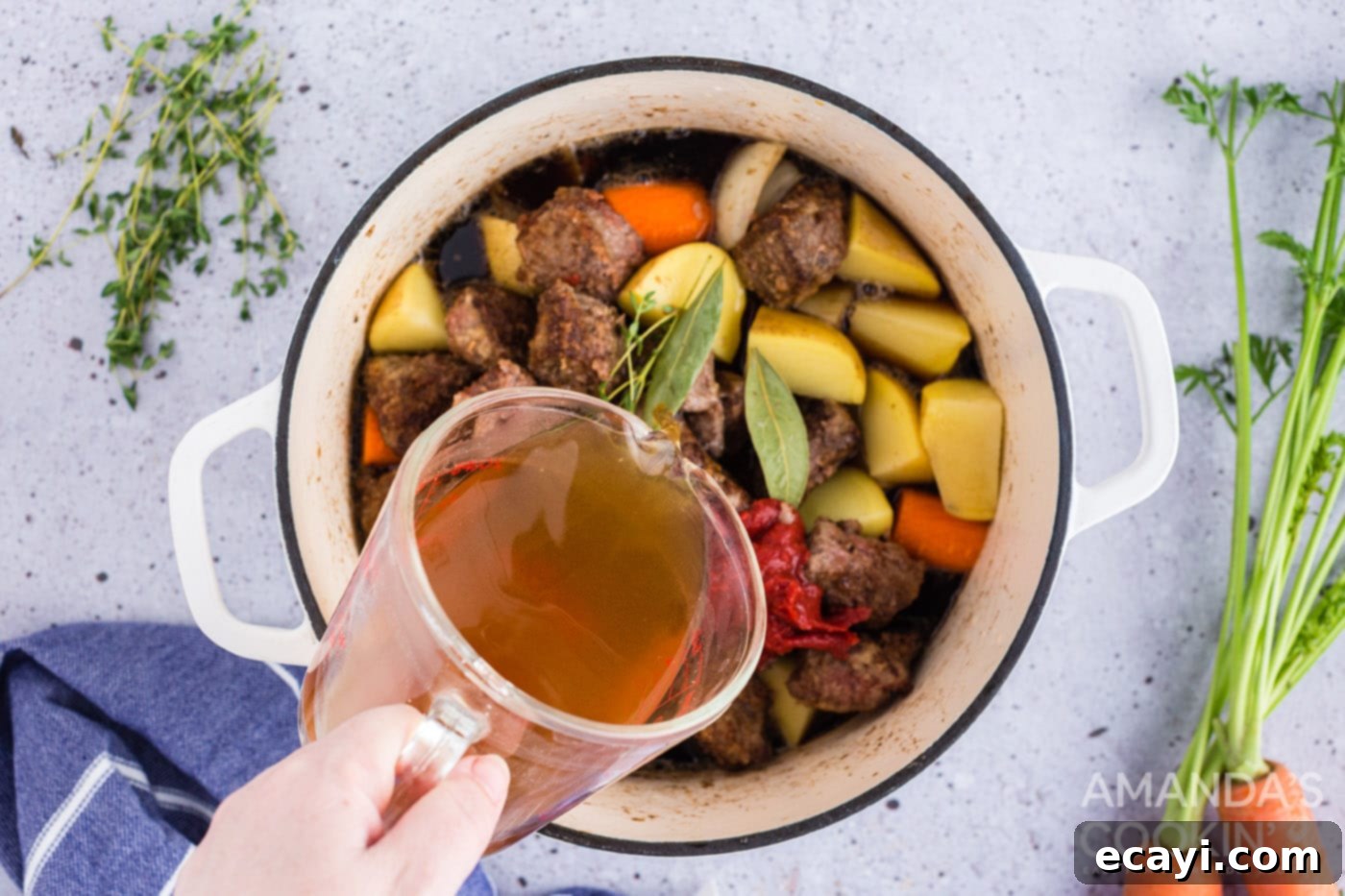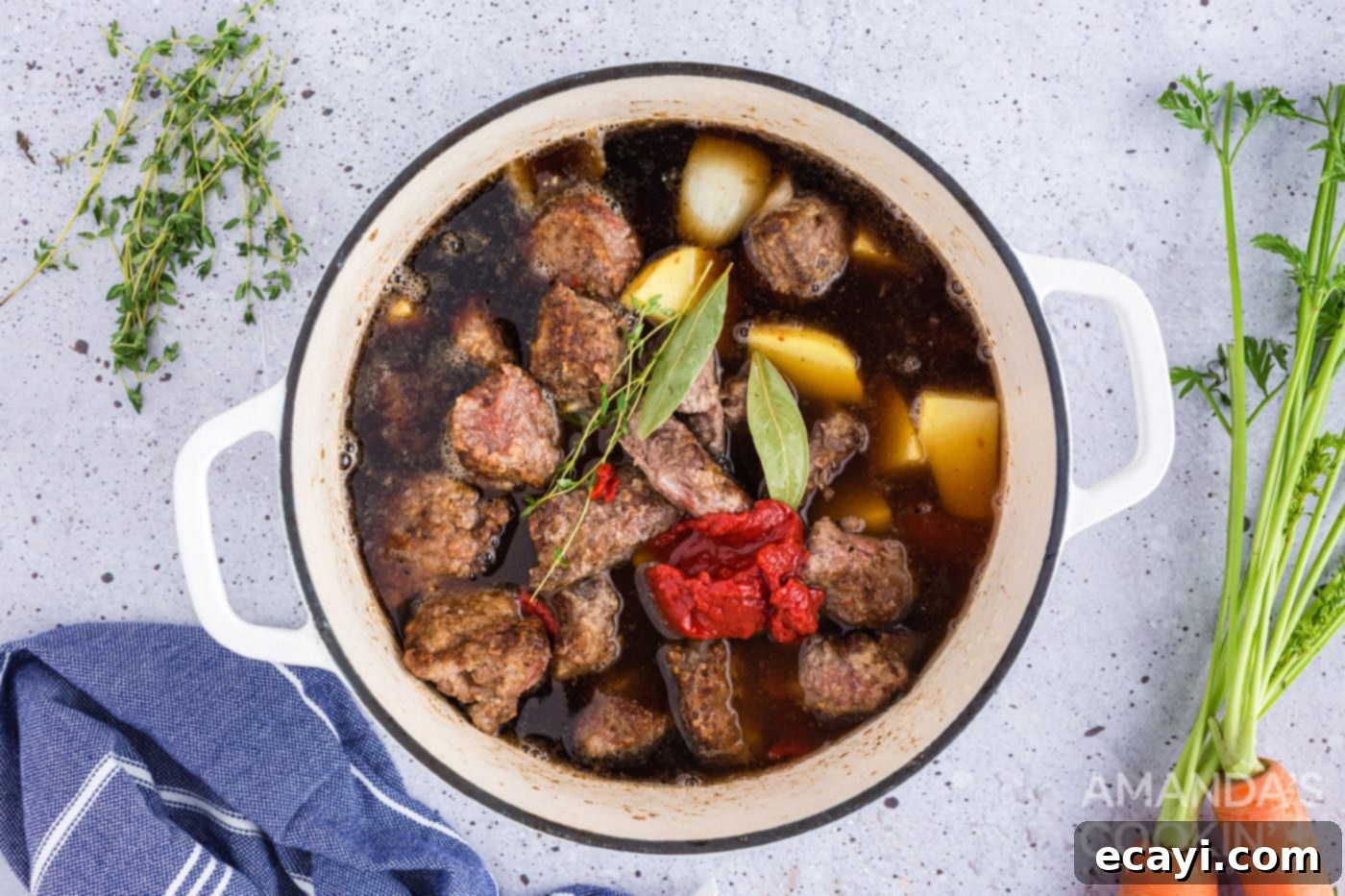Hearty Guinness Irish Stew: A Rich & Flavorful Classic Beef Recipe
Embrace the comforting warmth of a truly exceptional Irish Stew, a dish renowned for its deep, savory flavors and incredible heartiness. This recipe delivers a rich, delicious, and intensely satisfying meal, perfect for chilly evenings. The secret to its profound depth lies in the generous addition of Guinness beer, which imbues the broth with a complex, malty richness. Combined with an abundance of chunky, tender vegetables and succulent beef, this stew transforms into a robust culinary masterpiece that will warm you from the inside out.
Whether you’re celebrating St. Patrick’s Day, seeking a comforting Sunday dinner, or simply craving a taste of traditional Irish cuisine, this Guinness Irish Stew is an absolute must-try. Its slow-cooked perfection ensures every bite is packed with melt-in-your-mouth goodness and an unforgettable aroma that will fill your home.
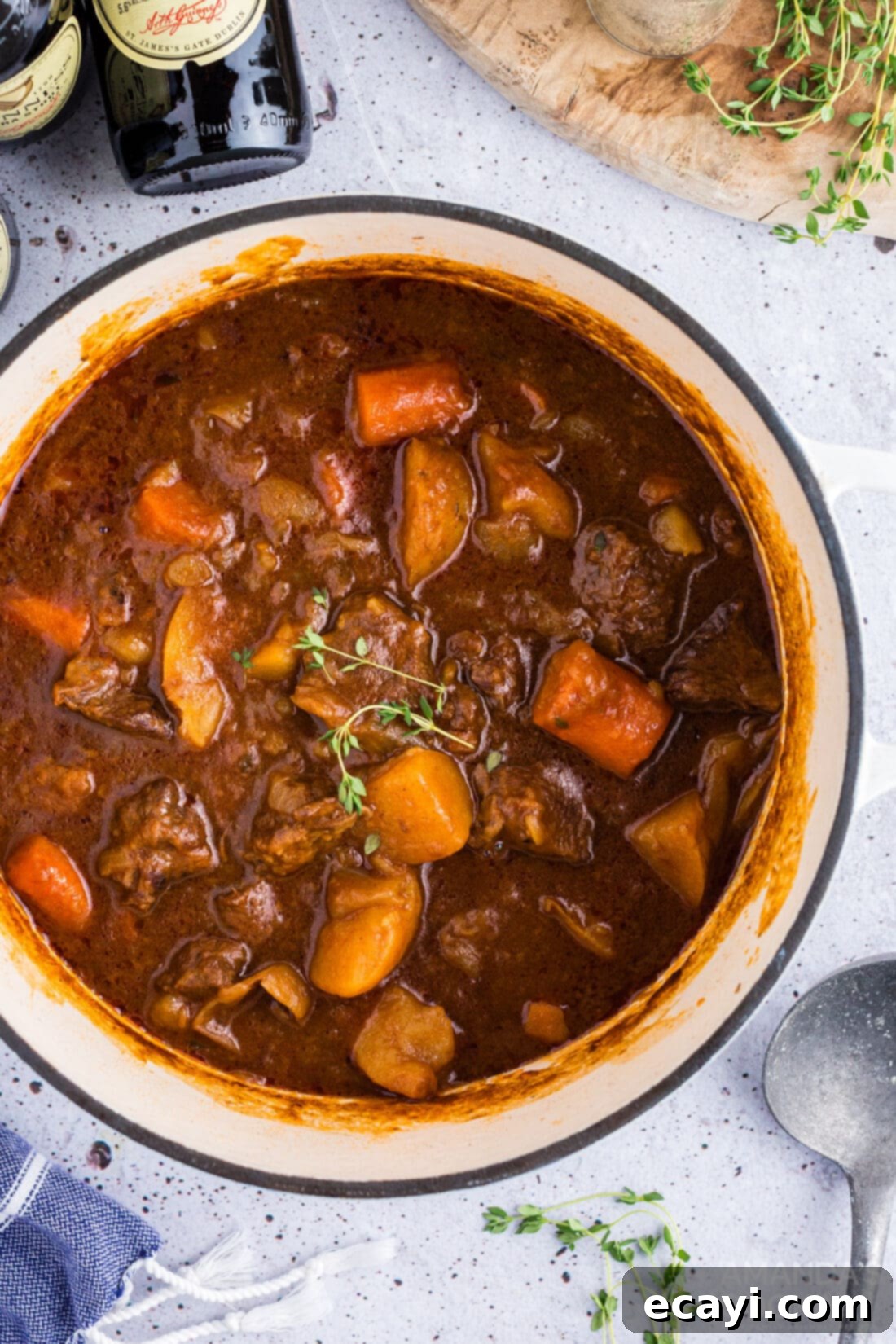
Why This Irish Stew Recipe Is Unbeatably Delicious
This Irish stew, affectionately dubbed “Guinness stew” by many, is a triumph of flavor, primarily due to the strategic inclusion of Guinness beer. The iconic Irish stout doesn’t just add liquid; it contributes a unique, slightly bitter, and deeply malty note that harmonizes beautifully with the savory beef and sweet root vegetables. This complexity is further enhanced by a carefully selected blend of seasonings and a touch of Worcestershire sauce, creating a robust and multi-layered taste profile that sets it apart from ordinary stews.
While traditional Irish stew often features lamb or mutton, our recipe opts for beef stew meat, specifically chuck roast, known for its marbling and ability to become incredibly tender when slow-cooked. This choice offers a familiar and universally loved flavor, yet we wholeheartedly encourage you to experiment with lamb for a more authentic, gamey taste if you prefer. Whichever meat you choose, the principle remains the same: a slow, gentle simmer transforms tough cuts into buttery-soft morsels. This slow-cooking method allows all the ingredients to meld together, developing a rich, thick gravy that clings to every piece of meat and vegetable. The resulting hearty pot of stew is a truly satisfying meal, perfect for warding off the chill of a crisp fall afternoon or a cold winter evening, inviting you to gather around the table and savor its comforting embrace.
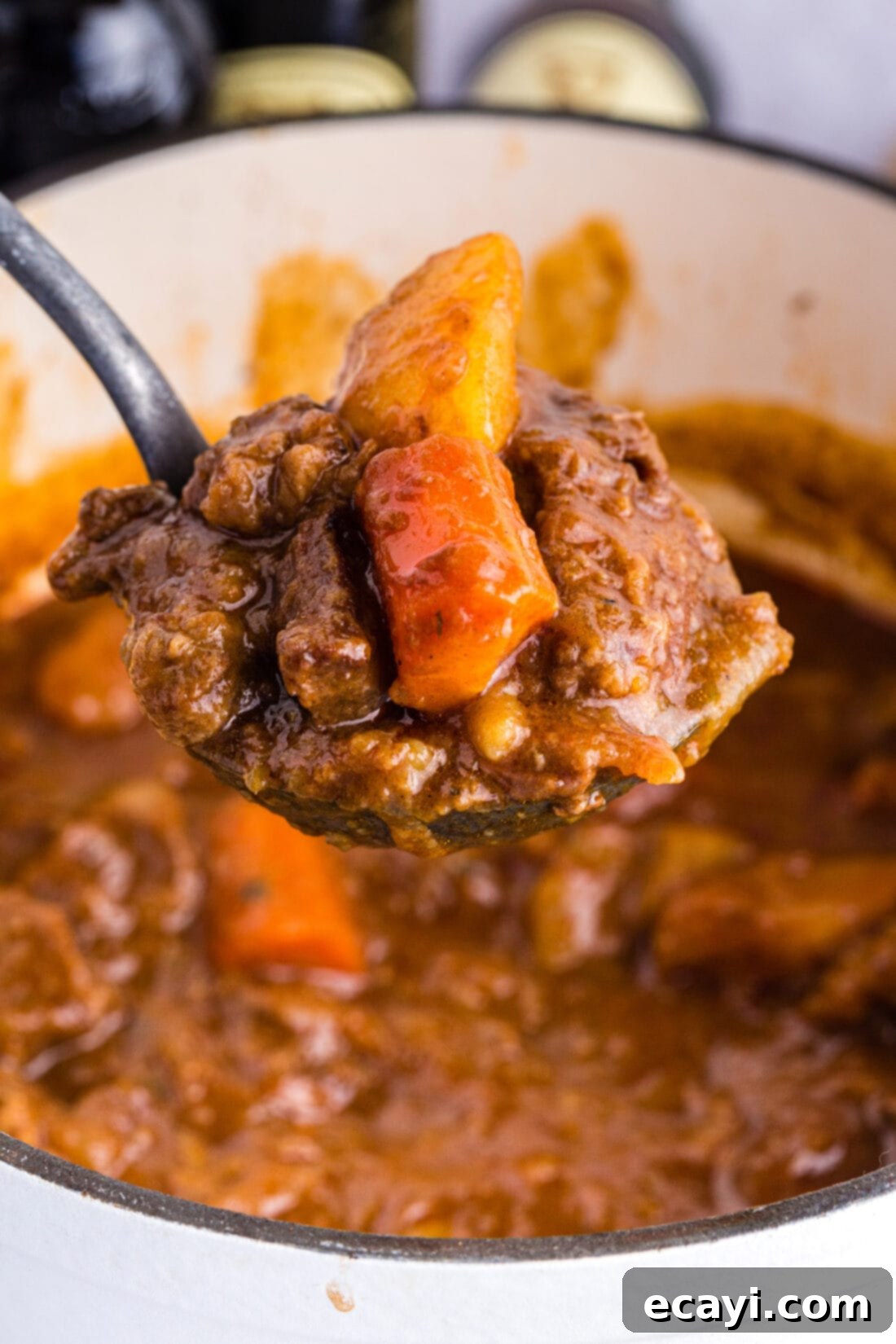
Key Ingredients for Your Hearty Irish Stew
Crafting a truly memorable Irish stew begins with selecting high-quality, fresh ingredients. While the full list with precise measurements is conveniently located in the printable recipe card at the end of this post, here’s a glance at the core components that bring this classic dish to life:
- Beef Stew Meat: We recommend chuck roast, cut into generous chunks, as it breaks down beautifully during slow cooking, becoming incredibly tender and flavorful.
- Guinness Beer: The cornerstone of a true “Guinness stew,” it provides unparalleled depth and a unique malty flavor.
- Root Vegetables: Large chunks of yellow potatoes and carrots are essential for heartiness and texture, holding their shape throughout the long simmer.
- Aromatics: Onion and garlic form the aromatic foundation, sautéed to release their sweet and pungent notes.
- Beef Broth: Complements the Guinness, creating a rich liquid base.
- Flavor Enhancers: Worcestershire sauce, tomato paste, bay leaves, and fresh thyme sprigs contribute layers of umami and herbaceous freshness.
- Seasoning & Thickener: Salt, pepper, and all-purpose flour are used to season and coat the meat, which also helps to thicken the stew as it cooks.
Ensuring your vegetables are cut into substantial pieces is crucial, as this allows them to stand up to the extended cooking time without turning mushy, maintaining their delightful texture within the robust stew.
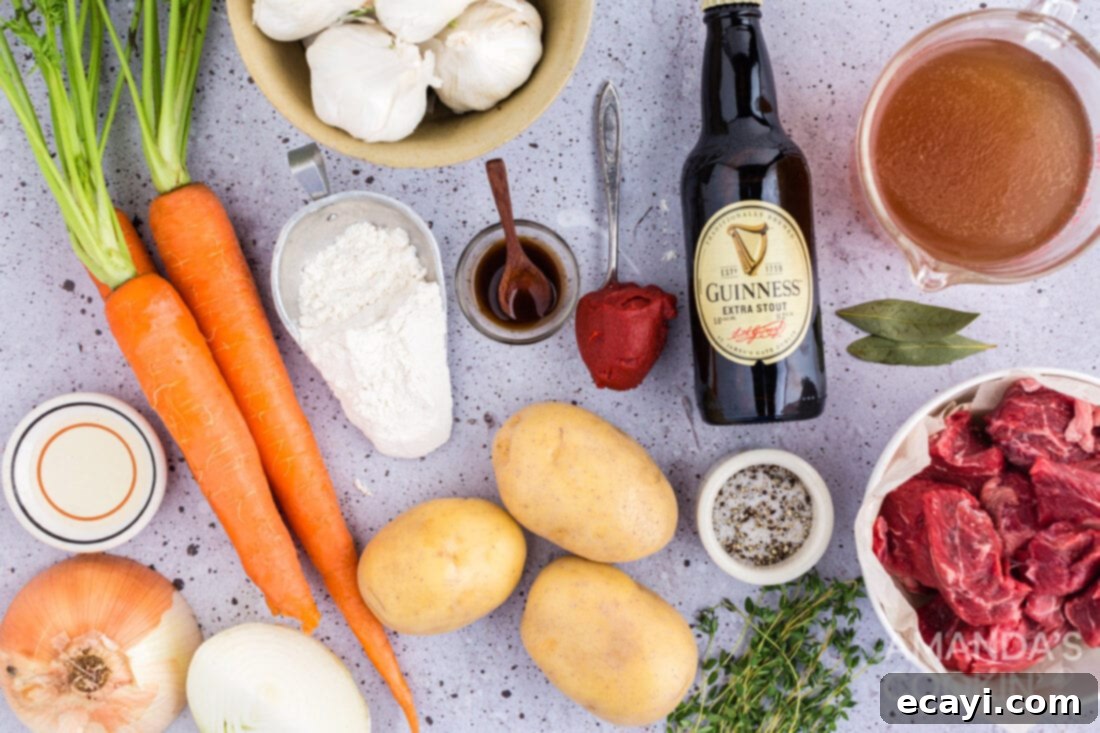
Mastering the Art of Irish Stew: Step-by-Step Guide
These step-by-step photos and detailed instructions are designed to help you visualize each stage of making this incredibly satisfying Irish Stew. For a complete printable version of this recipe, including exact measurements and a full ingredients list, simply Jump to Recipe at the bottom of this page.
- Prepare the Meat: Begin by combining the sea salt, black pepper, and all-purpose flour in a shallow dish or spread it evenly on a piece of parchment paper. Take your beef stew meat, ensure it’s patted dry, and toss it thoroughly in this flour mixture. This coating is crucial; it not only seasons the meat but also helps to achieve a beautiful brown crust during searing and acts as a natural thickener for the stew later on. Ensure all sides of each beef chunk are evenly coated.

- Sear the Beef: Heat the olive oil (or canola oil) over medium-high heat in a large Dutch oven or a robust stockpot. Once the oil is shimmering, carefully add the floured stew meat to the pot. It’s essential not to overcrowd the pot; if you do, the meat will steam instead of sear, preventing that delicious browned crust. Work in batches, browning the meat on all sides for about 5 minutes per batch. This browning step, known as the Maillard reaction, is vital for developing deep, complex flavors that form the backbone of your stew.


- Set Aside Meat: Once all the meat is beautifully browned, remove it from the pot using a slotted spoon and set it aside in a bowl. Leave any rendered fat and flavorful browned bits (fond) in the bottom of the pot – these are essential for the next step!
- Sauté Aromatics: If needed, add a small amount of additional oil to the pot. Add the chopped large onion and minced garlic. Sauté them gently for 3-5 minutes, stirring occasionally, until the onions soften and begin to caramelize around the edges, releasing their sweet aroma. Be careful not to burn the garlic, as it can turn bitter. The aromatics will also help to deglaze the pot, scraping up those flavorful browned bits from the beef.

- Layer in Vegetables and Meat: Add the large chunks of yellow potatoes and carrots directly over the softened onion and garlic in the pot. Then, return the browned stew meat back into the pot, nestling it amongst the vegetables and aromatics.

- Add Liquids and Flavorings: Pour the full bottle of Guinness beer and the beef broth over all the ingredients in the pot. Stir in the Worcestershire sauce, tomato paste, two bay leaves, and two sprigs of fresh thyme. Give everything a good stir to combine all the ingredients and ensure the tomato paste is dissolved, allowing the flavors to begin their mingling process.


- Slow Simmer for Tenderness: Bring the stew to a gentle boil over medium-high heat. Once boiling, reduce the heat to low, ensuring it maintains a slow, steady simmer. Cover the pot with a tight-fitting lid and cook for approximately 2 hours. This extended, low-heat cooking time is what breaks down the connective tissues in the beef, making it incredibly tender and allowing the flavors to deepen. Remember to stir the stew occasionally during this period to prevent it from sticking to the bottom of the pot and to ensure even cooking.

- Achieve Perfect Consistency: After the initial 2 hours of covered simmering, remove the lid. Continue to simmer the stew uncovered for an additional 15-30 minutes, or until the liquid has reduced to your desired thickness and the beef is perfectly fork-tender. The sauce will thicken beautifully as it reduces, concentrating the flavors even further. Taste and adjust seasonings if necessary before serving.
Tips for Crafting the Ultimate Irish Stew
Achieving a truly outstanding Irish stew is all about patience and a few key techniques:
- Quality Meat Matters: While chuck roast is excellent, don’t shy away from good quality lamb shoulder or leg for a more traditional flavor profile. Ensure the meat is cut into uniform, generous 1.5-inch pieces for even cooking.
- Don’t Skimp on Searing: Browning the meat properly is perhaps the most critical step for flavor development. The dark, caramelized crust adds immense depth (Maillard reaction) that cannot be replicated.
- Chunky Vegetables: As mentioned, keep your potatoes and carrots in large chunks. Smaller pieces will turn to mush during the long cooking time. You can also add other root vegetables like parsnips or celery for extra flavor and texture.
- The Role of Guinness: Use a traditional Irish stout like Guinness. Its distinct malty, slightly bitter notes are integral to the authentic flavor of this stew. Avoid lighter beers or those with strong hop profiles, which can alter the taste significantly.
- Low and Slow is Key: Resist the urge to rush the cooking process. The long, slow simmer is what makes the beef incredibly tender and allows all the flavors to marry beautifully.
- Adjusting Consistency: If your stew is too thin after simmering, you can create a slurry of 1-2 tablespoons of cornstarch mixed with an equal amount of cold water. Stir it into the simmering stew and cook for a few more minutes until thickened. If it’s too thick, simply add a splash more beef broth or water.
- Make Ahead Magic: Irish stew often tastes even better the next day! The flavors have more time to meld and deepen. This makes it an excellent candidate for meal prep or entertaining.
Frequently Asked Questions
Absolutely! Irish Stew freezes wonderfully, making it perfect for future quick and easy meals. To freeze, first ensure the stew has cooled completely to room temperature. Then, portion it into freezer-safe containers or heavy-duty freezer bags. If using bags, lay them flat for easy stacking. This stew can be safely stored in the freezer for up to 3 months. When ready to enjoy, thaw it in the refrigerator overnight and reheat gently on the stovetop or in the microwave, adding a splash of broth or water if needed to adjust consistency.
While this recipe is often celebrated as “Guinness Stew” for good reason, its unique flavor being so central to the dish, you can indeed substitute the beer if necessary. For a non-alcoholic alternative that still offers depth, a strong, rich “no salt added” beef broth is your best bet. If you’re open to other alcoholic options, a dry red wine like a Cabernet Sauvignon or Merlot can provide a similar complexity, although the flavor profile will differ slightly. Some recipes even suggest a strong, dark coffee (without grounds) for a similar bitter, roasted note, but use this sparingly as it can be quite potent.
The rich and hearty nature of Irish stew makes it a meal in itself, but it truly shines when paired with certain accompaniments. Crusty bread is always an excellent choice, perfect for soaking up every last drop of the delicious gravy. Consider serving it with our amazing Italian bread, classic homemade biscuits, or our aromatic herb buttermilk biscuits. For a touch of freshness and balance, a simple side salad with a light vinaigrette would be a fantastic addition. Don’t forget a sprinkle of fresh chopped parsley over the top just before serving for an appealing pop of color and herbaceous flavor.
Yes, absolutely! While this recipe provides instructions for a Dutch oven, it can easily be adapted for a slow cooker or Instant Pot. For a slow cooker, follow the browning steps for the meat and sautéing the aromatics on the stovetop first (or use the sauté function if your slow cooker has one). Then, combine all ingredients in the slow cooker and cook on low for 6-8 hours or on high for 3-4 hours, until the meat is tender. For an Instant Pot, use the sauté function for browning the meat and aromatics. Then, add remaining ingredients, set to high pressure for 35-40 minutes (for beef), and allow a natural pressure release for at least 15 minutes before quick releasing any remaining pressure.
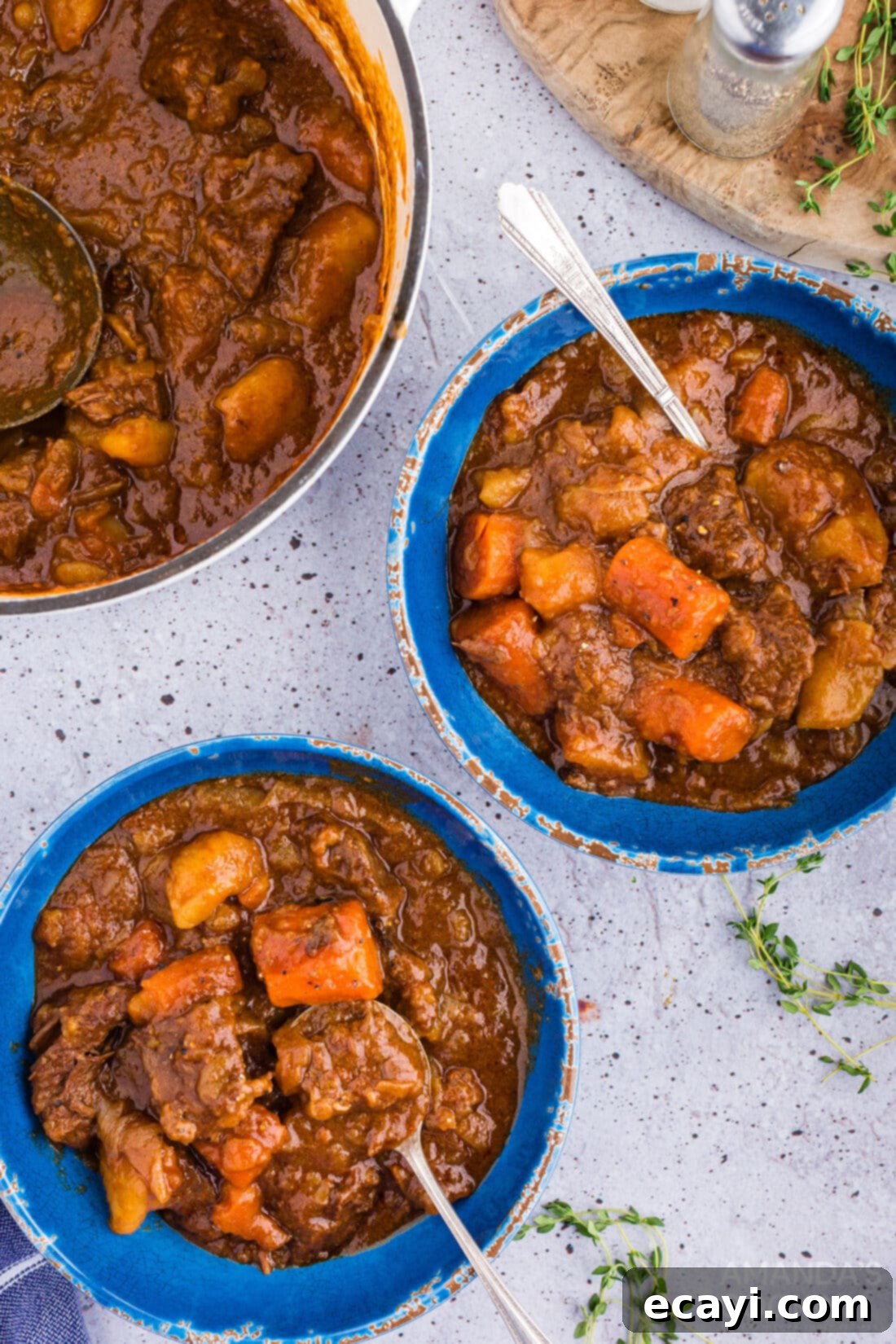
Perfect Serving Suggestions for Your Irish Stew
Once your beef stew has simmered to perfection, with the meat meltingly tender and the vegetables soft yet holding their shape, it’s ready to be savored. The rich, thick gravy, infused with the deep flavors of Guinness and herbs, is a meal in itself. Serve generous ladles of this comforting stew into warm bowls, and for an extra touch of freshness and vibrant color, garnish with a sprinkle of freshly chopped parsley or a few fresh thyme leaves.
This slow-cooked masterpiece pairs beautifully with simple, rustic sides. A warm, crusty loaf of bread is essential for mopping up every last drop of the savory sauce. Traditional Irish soda bread is an ideal choice, or a good quality artisan sourdough or French baguette works wonderfully. For a light counterpoint, a crisp green side salad dressed with a tangy vinaigrette can cut through the richness of the stew, offering a refreshing balance to your meal. This combination promises a hearty, satisfying dinner that your family and friends are sure to adore, bringing a taste of Irish comfort food right to your table!
We truly hope you enjoy every flavorful spoonful!
More Hearty Beef Recipes You’ll Love
If you’re a fan of comforting and flavorful beef dishes, you’ll be delighted by these other fantastic recipes from our collection. From creamy pasta dishes to robust stews, there’s something here to satisfy every craving:
- Creamy Beef Stroganoff
- Hearty Hamburger Stew
- Classic Corned Beef and Cabbage
- Instant Pot Corned Beef
- Crockpot Corned Beef
- Elegant Beef Bourguignon
I love to bake and cook and share my kitchen experience with all of you! Remembering to come back each day can be tough, that’s why I offer a convenient newsletter every time a new recipe posts. Simply subscribe and start receiving your free daily recipes!

Irish Stew
IMPORTANT – There are often Frequently Asked Questions within the blog post that you may find helpful. Simply scroll back up to read them!
Print It
Pin It
Rate It
Save ItSaved!
Ingredients
- 1 teaspoon sea salt
- 1 teaspoon black pepper
- ½ cup all purpose flour
- 1.5 lbs beef stew meat
- 2 Tablespoons olive oil or canola oil
- 1 onion large, cut into large chunks
- 2 teaspoon minced garlic
- 3 large carrots cut into large chunks
- 3 yellow potatoes cut into large chunks
- 11.2 oz Guinness beer 1 bottle
- 3 cups beef broth
- 1 teaspoon Worcestershire sauce
- 3 oz tomato paste
- 2 bay leaves
- 2 sprigs fresh thyme plus more for garnish
- fresh parsley chopped, for garnish
Things You’ll Need
-
Large stockpot
-
Cutting board
Before You Begin
- Keep the vegetables and potatoes in large chunks so that they hold up to the lengthy cook time and maintain their texture.
- For optimal flavor, use a good quality Irish stout like Guinness. The unique maltiness is key to this stew’s authentic taste.
Instructions
-
Combine salt, pepper, and flour in a shallow dish. Spread the flour mixture evenly and toss the stew meat in it to coat thoroughly on all sides. This coating helps to brown the meat and thicken the stew.
-
Heat olive oil (or canola oil) over medium-high heat in a large Dutch oven or stockpot. Brown the floured stew meat on all sides for about 5 minutes per batch. Do not overcrowd the pot; work in batches to ensure proper searing and flavor development.
-
Remove the browned meat from the pot and set it aside, leaving any rendered fat and delicious browned bits in the pot.
-
Add additional oil if needed. Add the chopped onion and minced garlic to the pot and sauté for 3-5 minutes, stirring until the onions soften and begin to caramelize slightly. Be careful not to burn the garlic.
-
Add the large chunks of potatoes and carrots to the pot, layering them over the onion and garlic. Then, return the browned meat back into the pot, placing it over the other ingredients.
-
Pour the Guinness beer and beef broth over the meat and vegetables. Stir in the Worcestershire sauce, tomato paste, bay leaves, and two sprigs of fresh thyme. Mix well to combine all the flavors.
-
Bring the stew to a boil over medium-high heat. Once boiling, reduce the heat to low, cover the pot with a lid, and cook for approximately 2 hours. Stir occasionally to prevent sticking and ensure even cooking, allowing the beef to become incredibly tender.
-
After 2 hours, remove the lid and continue simmering the stew uncovered for an additional 15-30 minutes. This allows the liquid to reduce and thicken to your desired consistency, and ensures the meat is perfectly fork-tender. Taste and adjust seasonings if necessary.
Expert Tips & FAQs
- For the best flavor, allow the stew to cool completely before storing. It can be stored in an airtight container in the refrigerator for up to 4 days, or frozen for up to 3 months.
- Don’t rush the browning of the meat; this step is crucial for developing deep, rich flavors in your stew.
- Ensure your vegetables are cut into substantial chunks so they hold their shape and texture during the long cooking time.
Nutrition
The recipes on this blog are tested with a conventional gas oven and gas stovetop. It’s important to note that some ovens, especially as they age, can cook and bake inconsistently. Using an inexpensive oven thermometer can assure you that your oven is truly heating to the proper temperature. If you use a toaster oven or countertop oven, please keep in mind that they may not distribute heat the same as a conventional full sized oven and you may need to adjust your cooking/baking times. In the case of recipes made with a pressure cooker, air fryer, slow cooker, or other appliance, a link to the appliances we use is listed within each respective recipe. For baking recipes where measurements are given by weight, please note that results may not be the same if cups are used instead, and we can’t guarantee success with that method.
This post was originally published here on February 15, 2021.
